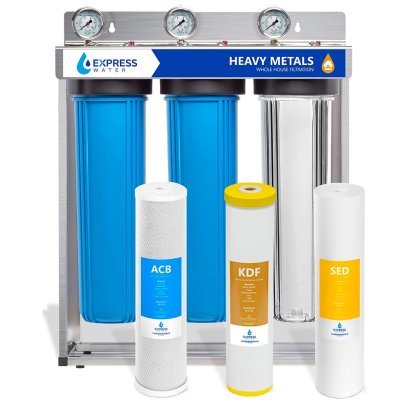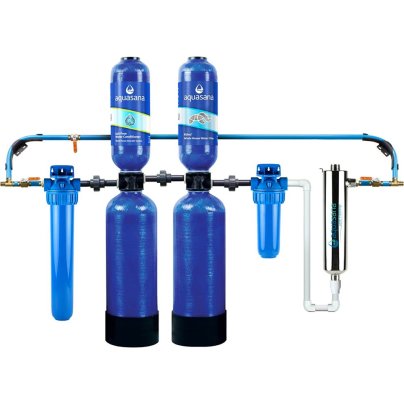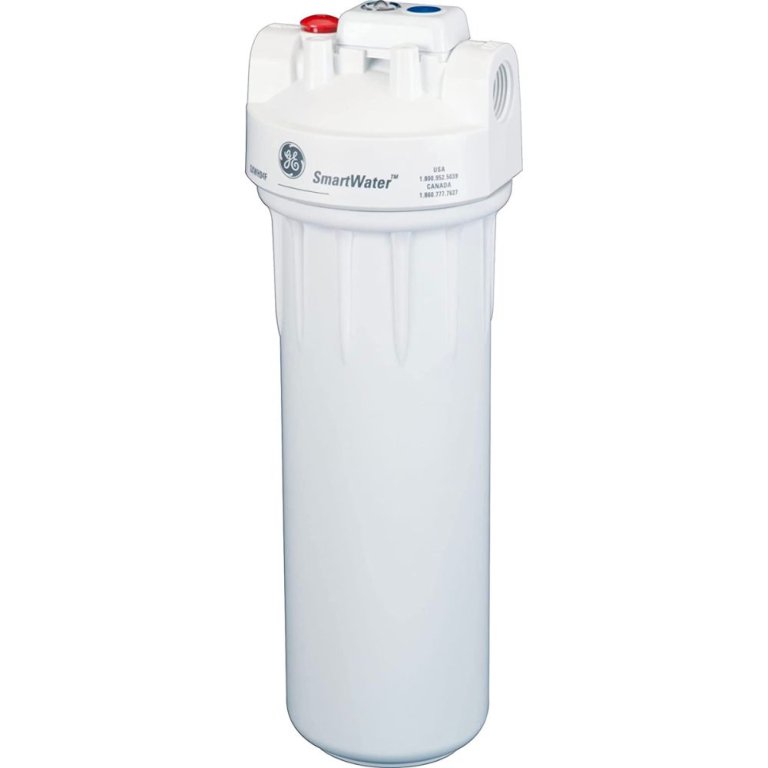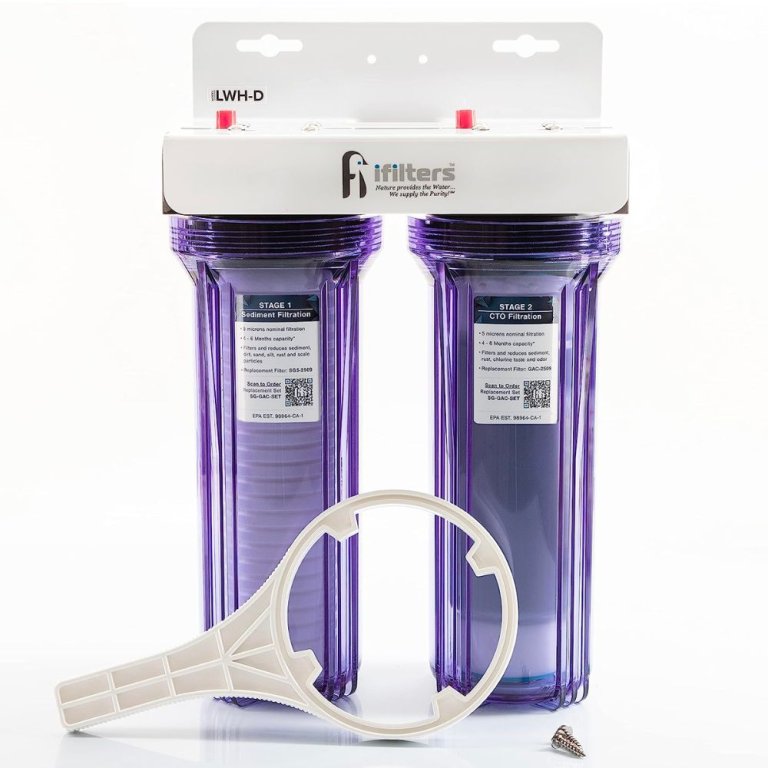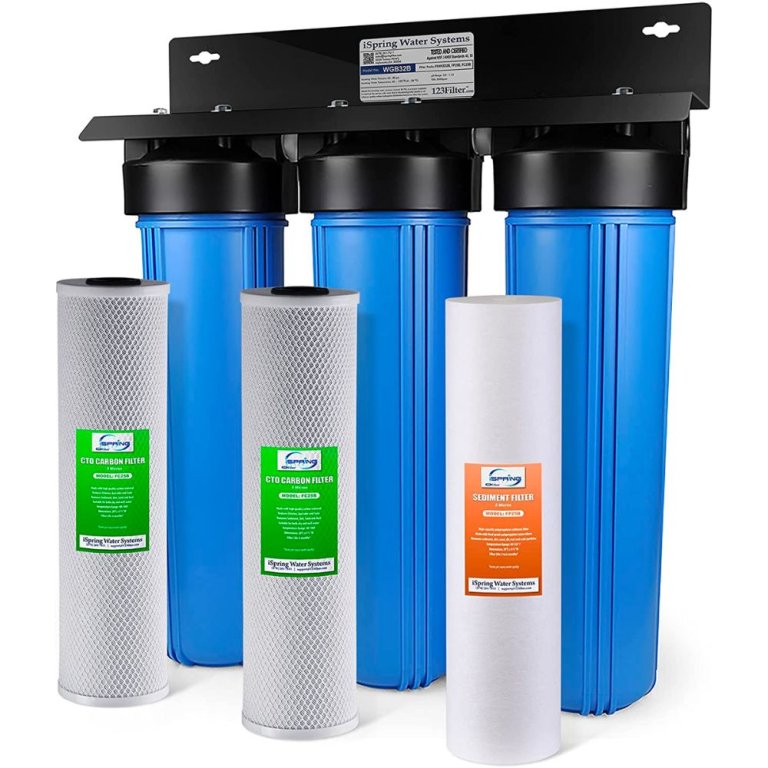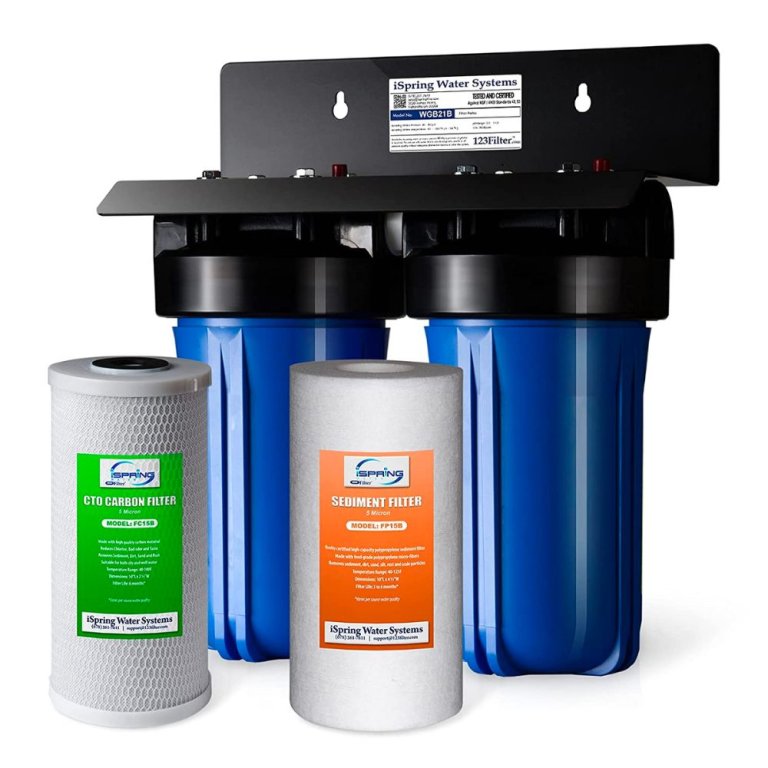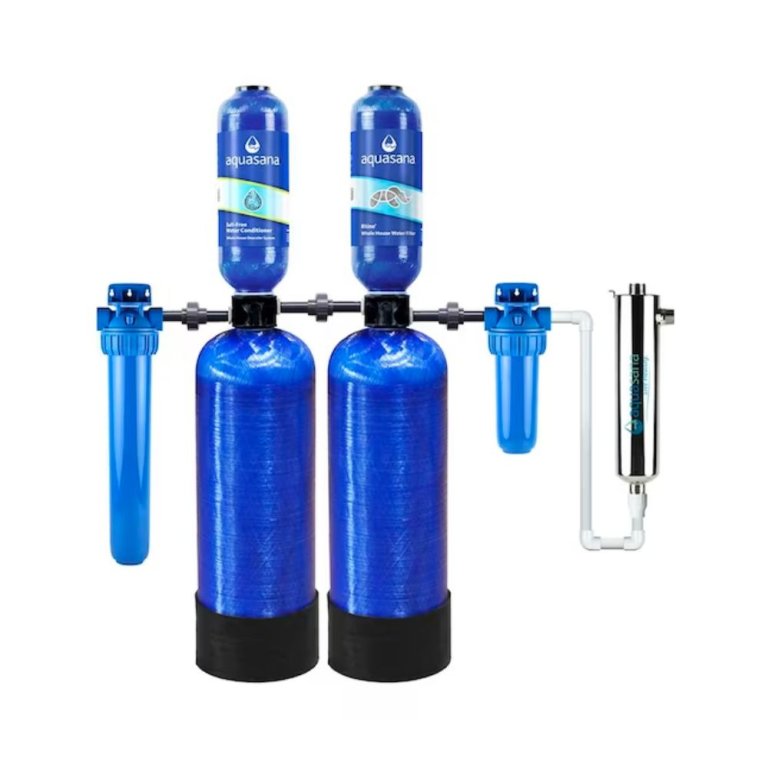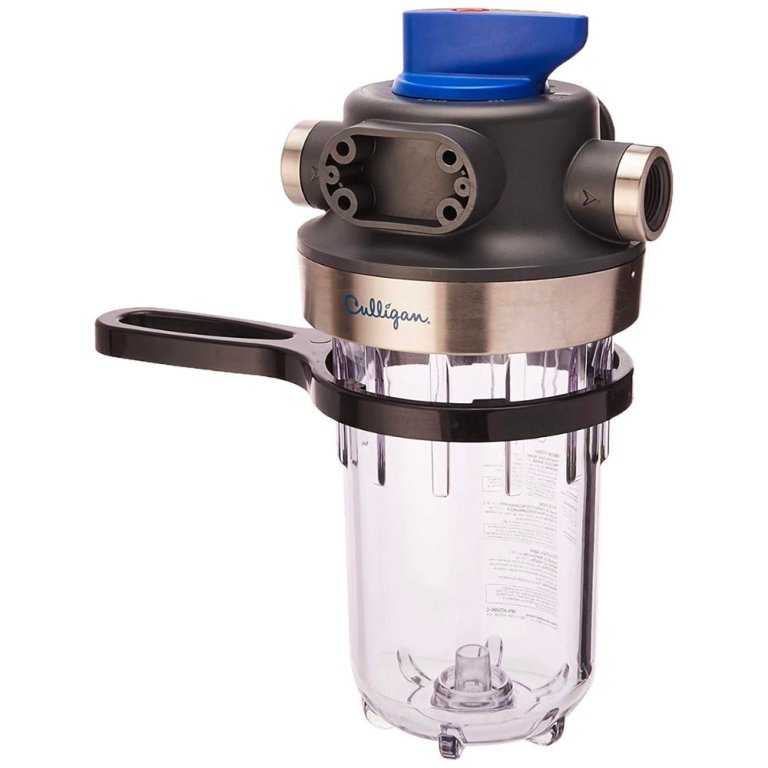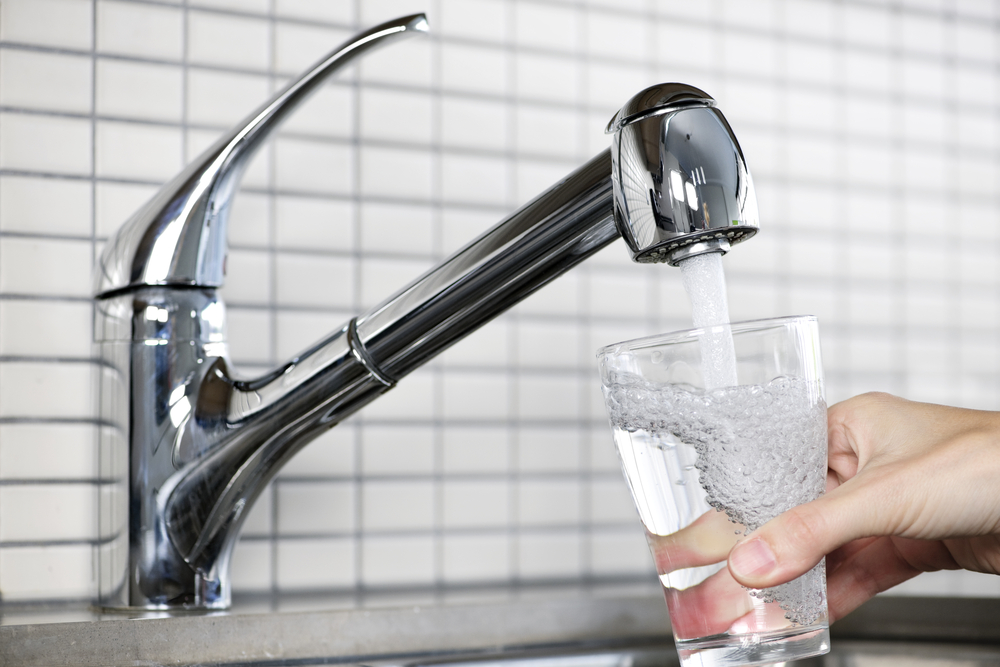
We may earn revenue from the products available on this page and participate in affiliate programs. Learn More ›
Well and city water can contain a range of contaminants. Though there are several water filter options to treat incoming water, it may be better to use a whole-house water filtration system for clear, filtered water as soon as it enters the home plumbing system.
Whole-house water filters are common in areas with hard water but can be used to improve the quality of water in other locations, too. As a plumbing project manager, I have had the opportunity to work with a variety of whole-house water filters, including GE, Aquasana, and Aqua Pure models, often needing to re-install the filtration system after making room for a main shut-off valve or water meter. I researched more than 25 whole-house systems, drawing on my personal experience in the plumbing industry, to come up with this list of the best whole-house water filters. I weighed the type, flow rate, installation difficulty, filtration capabilities, and NSF or ANSI certification to find the top products available.
The best whole-house water filter can come in 1-stage, 2-stage, or 3-stage options, with whole-house water filtration capabilities increasing with each added stage. These house water filter systems can also incorporate water softeners to reduce hard metals and improve overall water quality. Keep in mind the key considerations detailed in the following sections, and check out some of the top products on the market.
- BEST OVERALL: Express Water Heavy Metal Whole-House Water Filter
- BEST BANG FOR THE BUCK: GE GXWH04F Water System
- BEST FILTER/SOFTENER COMBO: Aquasana EQ-1000-AST-UV Whole-House Filter
- BEST 1-STAGE FILTER: 3M Aqua-Pure Whole-House Sanitary Quick Change
- BEST 2-STAGE FILTER: iFilters Whole-House 2-Stage Sediment
- BEST 3-STAGE FILTER: iSpring WGB32B 3-Stage Whole-House Water Filtration
- BEST FOR CITY WATER: iSpring WGB21B 2-Stage Whole-House Water Filtration
- BEST FOR WELL WATER: Aquasana Whole-House Well Water Filter System
- BEST 1-INCH INLET: Culligan WH-HD200-C Heavy Duty Filter Housing

How We Chose the Best Whole-House Water Filters
A whole-house filtration system provides enhanced water quality for better tasting and smelling drinking water, and prevents harmful minerals and toxins from polluting your cleaning and drinking water supply. Selections for the best options available depended upon the type, flow rate, filtration, compatibility with household water systems, the longevity of the filter’s cartridges, and ease of installation.
As the type of water filter greatly influences the level of filtration included, the above list has prioritized 1-stage, 2-stage, and 3-stage options for different levels of filtration and personal preference. With these types in mind, many of the above models come with varying flow rates of 3 to 20 GPM depending upon an individual home’s water consumption. The above water and sediment filters also vary between 1-inch and ¾-inch inlets or connections to be compatible with your home’s current water system.
Cartridges are also key in whole-house water filtration systems, which is why most last anywhere between 3 months and 1 year depending upon water consumption and filtration type. Finally, each of the above water filtration systems is easy or moderately difficult to install. But, most come with informational guides and kits which should make the process easier.
Our Top Picks
These products are considered among the best whole-house water filters on the market. The top whole-house water filtration system options were chosen based on important product information and the most sought-after features, with significant attention given to product efficacy and overall value.
Best Overall
Express Water Heavy Metal Whole-House Water Filter
See ItPros
- Filter cartridges can last about 6 months and up to 1 year
- Removes 5 micron-sized filtration medialike sediment, sand, rust, and dirt
- Easy-to-change filters with twist-off cartridges
- Solid freestanding stainless steel frame included
Cons
- Total dissolved solids are not filtered
- The current pipes must be 1-inch in diameter to be compatible with this filtration system
Product Specs
- Type: 3-stage filtration
- Flow rate: 15 GPM
- Ease of installation: Easy
The best type of cartridge filter available is usually a 3-stage whole-house water filter because they can be equipped with three different filter cartridges, allowing this whole-house filtration system to remove a wide range of contaminants. The Express Water whole-house water filter comes with three filter cartridges that last for 6 months to a year before needing to be replaced.
This whole-house filter has a 15 GPM flow rate and 1-inch connections, so users need to make sure their incoming pipes are 1 inch in diameter. The first stage of the whole-house water filtration process removes sediment, sand, rust, and dirt down to a size of 5 microns.
The second stage of this house water filtration system captures iron, lead, chloramine, algae, viruses, chlorine, and other heavy metals and microorganisms. The final stage captures filtration media like chlorine, pesticides, pharmaceutical runoff, and other chemicals, improving the taste of the drinking water.
Get the Express Water whole-house water filter at Amazon, The Home Depot, or Wayfair.
Best Bang for the Buck
GE GXWH04F Water System
See ItPros
- Filters dirt, silt, sand, rust, and other sediments to improve the taste and quality of drinking water
- Reminder light indicates when it’s time to change sediment filters
- Uses a standard ¾-inch inlet connections
- Mounting bracket included for easier installation
Cons
- Some users have reported manufacturing defects in this house water filtration system
- Water filter cartridges only last 3 months
Product Specs
- Type: 1-stage filtration
- Flow rate: 4 to 12 GPM
- Ease of installation: Easy
This well-priced General Electric whole-house water filter is made to be used with GE whole-home system filter cartridges, which have a range of filtration capabilities to remove dirt, silt, sand, rust, and other filtration media from the incoming water supply. Each whole-house filter cartridge lasts for up to 3 months, improving the quality, odor, and taste of the home’s drinking water.
This whole-house water filter has a maximum flow rate of 12 GPM, though it works best at a water flow rate of 4 GPM. The inlet connections for this house filter are 3/4-inch diameter, and this water filter also comes with a mounting bracket to make installation easier. A reminder light on the water filter indicates when to change the filter cartridge, so users don’t need to estimate.
Get the GE whole-house water filter at Amazon or The Home Depot.
Best Filter/Softener Combo
Aquasana EQ-1000-AST-UV Whole-House Filter
See ItPros
- UV purifier included to kill 99.9 percent of viruses, bacteria, and other microorganisms
- Thoroughly filters chlorine, pharmaceuticals, and minerals like iron and lead
- Cartridges need to be changed every 2 to 3 months
- Installation kit includes fittings for either ¾- or 1-inch pipes
Cons
- Expensive price point for a house water filtration system with a lower flow rate
- Some parts may be shipped in separate packages
Product Specs
- Type: Carbon and KDF filtration
- Flow rate: 14 GPM
- Ease of installation: Moderate
The Aquasana whole-house water filtration system features carbon and kinetic degradation fluxion (KDF) filtration cartridges that last up to 3 months, capturing filtration media like iron, lead, chloramine, chlorine, pharmaceuticals, and a variety of other contaminants.
It also has a UV purifier that kills viruses, bacteria, and 99.9 percent of other microorganisms. After filtration and purification, the drinking water passes through the salt-free softener. It coats any heavy metal minerals that passed through the filters, preventing them from sticking to the pipes, faucets, and hot water tank, providing better water quality.
While there is a high cost associated with this whole-home water filtration system, few products are more capable of removing contaminants from the entire home’s water supply, including 99.9 percent of microorganisms, 97 percent of chlorine, and a significant reduction in the mineral buildup. Though the water filter only has a maximum water flow rate of 14.5 GPM, it can be adapted to either 3/4-inch or 1-inch pipes.
Get the Aquasana EQ-1000-AST-UV whole-house water filter at Amazon or The Home Depot.
Best 1-Stage
3M Aqua-Pure Whole House Sanitary Quick Change
See ItPros
- Easy-change carbon filter cartridge included; lasts for 6 months
- 1-inch inlet connection with a flow rate of up to 20 GPM
- Locking mechanism; easy to install replacement cartridges
- Removes chlorine, sand, rust, and other sediments
Cons
- May not be the best option for well water
- Some users have reported issues with filtration
Product Specs
- Type: 1-stage filtration
- Flow rate: 10 to 20 GPM
- Ease of installation: Easy
This 3M Aqua-Pure whole-house water filter is a 1-stage filter with a single filtration tank that’s equipped with a carbon filter cartridge. The whole-house water filter removes chlorine, sand, dirt, rust, and other sediments from the water. It has a 1-inch inlet connection and a maximum water flow rate of 20 GPM, though the filter performs best at 10 GPM.
The filter cartridge lasts for about 6 months to a year, depending on the average amount of daily water used in the home. When it’s time to change the filter, users don’t need to unscrew the filter; instead, they’ll just pull the locking latch upward, turn it a quarter-turn to the left, then pull down. Replace the filter cartridge, then reattach the filter and lock the latch to secure the house filter with no leaks.
Get the 3M Aqua-Pure whole-house water filter at Amazon.
Best 2-Stage
iFilters Whole-House 2-Stage Sediment
See ItPros
- Sediment and carbon filtration provided; tackles sand, dirt, rust, silt, and chlorine
- Compatible with ¾-inch pipes
- Built-in pressure relief valves simplify filter replacement
- Universal ports for any home installation
Cons
- Some users have reported decreased water pressure and manufacturing defects
- Lower max flow rate than others; though most users note typical rate is just 3 GPM
Product Specs
- Type: 2-stage filtration
- Flow rate: 3 GPM
- Ease of installation: Easy
The iFilters whole-house water filter is a 2-stage filtration system that uses both sediment filters and a carbon filter to remove harmful contaminants from the incoming water supply, including sand, dirt, rust, silt, and chlorine. This improves the taste, odor, and overall quality of the water, filtering out any particles larger than 5 microns in size.
Install the whole-house water filter on 3/4-inch pipes, or adapt existing plumbing to fit the 3/4-inch connections. Take advantage of the built-in pressure relief valves to quickly and efficiently remove the filter housing to replace the filter cartridge about once every 6 months.
However, users should note that the typical flow rate for this 2-stage filter is just 3 GPM, though it does have a maximum flow rate of about 6 GPM. This means that the water pressure in the home may be reduced to certain plumbing fixtures, like the shower or dishwasher, with the installation of this filter.
Get the iFilters whole-house water filter at Amazon, Lowe’s, or The Home Depot.
Best 3-Stage
iSpring WGB32B 3-Stage Whole-House Water Filtration
See ItPros
- Built-in sediment removal and carbon block cartridges
- Filters out a wide range of contaminants, including chlorine, VOCs, iron, manganese, and harmful chemicals
- KDF filter cartridge increase the efficacy of this system
- Cartridges last for 6 to 12 months
Cons
- Not suitable for use in sunlight or freezing temperatures
- Some users have reported leaks
Product Specs
- Type: 3-stage filtration
- Flow rate: 15 GPM
- Ease of installation: Easy
This iSpring product is a good option for those who have significant concerns about the quality of the incoming water. This 3-stage water filtration can remove a wide range of contaminants using the three individual filtration tanks and included filter cartridges.
The water filter comes equipped with a sediment removal cartridge that traps sand, dust, silt, dirt, and rust. It also has a carbon block cartridge to remove chlorine, VOCs, harmful chemicals, and to improve the taste and odor of the water. The third cartridge is an iron- and manganese-reducing filter cartridge, ideal for homes with heavy metals.
The whole-house water filter is also available with a KDF filter cartridge that can remove lead, mercury, pesticides, herbicides, and hydrogen sulfide, which may be a better option for some users. This water filter has a high maximum flow rate of 15 GPM and has 1-inch connections. The filter cartridges should be replaced every 6 to 12 months, depending on the amount of water typically used in the home.
Get the iSpring 3-stage whole-house water filter at Amazon, Lowe’s, The Home Depot, Wayfair, or Overstock.
Best for City Water
iSpring WGB21B 2-Stage Whole-House Water Filtration
See ItPros
- Suitable for use with well or city water
- 1-inch connections and healthy flow rate of up to 15 GPM
- Carbon filter cartridge included to remove chlorine, VOCs, and other harmful chemicals
- Comes pre-assembled into the mounting bracket
Cons
- Does not filter out total reduced solids
- May require additional reverse osmosis system
Product Specs
- Type: 2-stage filtration
- Flow rate: 15 GPM
- Ease of installation: Easy
This whole-home water filter is specifically made for use with city water and can filter up to 95 percent of chlorine out of the incoming water supply. It has 1-inch connections and a maximum flow rate of 15 GPM, so that showers, washing machines, and dishwashers are not impacted by the installation of the filter.
The activated carbon filter cartridge of this iSpring whole-house water filter can remove chlorine, VOCs, and harmful chemicals, improving the taste and odor of the water. The sediment filter removes dust, sand, silt, dirt, and rust, so that no particles larger than 5 microns pass through the filtration system. These filter cartridges last for 6 months to a year, depending on the amount and the condition of the water used by the household.
Get the iSpring 2-stage whole-house water filter at Amazon or The Home Depot.
Best for Well Water
Aquasana Whole-House Well Water Filter System
See ItPros
- Sediment pre- and post-filter, activated carbon filter, and UV filter
- Removes 99 percent of viruses, bacteria, and microorganisms and significantly reduces chlorine
- Salt-free water softener that is low maintenance
Cons
- Large unit takes up a substantial amount of space and might be hard to install without professional help
Product Specs
- Type: Carbon and KDF filtration
- Flow rate: 7 GPM
- Ease of installation: Moderate
Those with private well water systems can experience significant contamination in the water supply, so it’s advised to invest in a whole-house water filtration system. This Aquasana product incorporates a sediment pre-filter, an activated carbon filter, a sediment post-filter, and a UV filter to remove up to 99.99 percent of viruses, bacteria, and other microorganisms; and a significant reduction of chlorine, lead, mercury, pesticides, VOCs, and more.
The whole-house water filter also includes a salt-free water softener that coats any heavy metals to prevent them from binding to water pipes, faucets, and other plumbing fixtures. This water filter has a maximum flow rate of 7 GPM, and the filter should be replaced every 5 years. The drawback of this system is that it takes up a lot of space and may be difficult to install. Consider hiring a professional plumber or water filter installation technician.
Get the Aquasana well water whole-house water filter at Lowe’s.
Best 1-Inch Inlet
Culligan WH-HD200-C Heavy Duty Filter Housing
See ItPros
- Heavy-duty sediment filter included with a maximum flow rate of 10 GPM
- Compatible with 12 different cartridges from Culligan to meet the needs of water composition and plumbing system
- Cartridges last for 3 to 6 months (depending upon selected cartridge)
Cons
- Some users report difficulty when installing the system
- More complicated system than others on the list
Product Specs
- Type: 1-stage filtration
- Flow rate: 4 to 10 GPM
- Ease of installation: Moderate
Connect this whole-house filter system to 1-inch piping with its 1-inch inlet and outlet connections. The large diameter of the water inlet and outlet helps prevent the reduction of water pressure in the home, though the specific water filter cartridge can impact the flow rate. This product comes equipped with a heavy-duty sediment filter to remove rust, sand, sediment, and other material from the water and has a maximum flow rate of 10 GPM.
The Culligan whole-house water filter can also be used with 12 kinds of Culligan filter cartridges to remove a wide range of contaminants based on the water composition and quality of the home plumbing system.
- Choose any of the six standard filter cartridge options if a maximum flow rate of 4 GPM is acceptable, replacing the cartridges every 3 to 4 months.
- Or, go for any of the six heavy-duty filter cartridge options, which increase the flow rate to a maximum of 10 GPM and last for up to 6 months before they need to be replaced.
Get the Culligan whole-house water filter at Amazon, Ace Hardware, or Target.
Jump to Our Top Picks
What to Consider When Choosing a Whole-House Water Filter
Before choosing a filtration system, take time to weigh some important factors that can help narrow the options so you make the best choice. Some key factors to consider include the type of contaminants, flow rate, and installation requirements. With an understanding of these features, it becomes easier to decide which option is the best whole-house water filter for your home.
Types of Whole-House Water Filters
There are a variety of filter types for whole-house systems, including 1-stage, 2-stage, or 3-stage cartridge-based filters, and reverse osmosis systems. These filters work to remove unnatural tastes, smells, and undesirable matter.
Cartridge Whole-House Water Filters
These water filters use a replaceable cartridge to remove contaminants ranging from 0.04 to 500 microns. Cartridges can include sediment filters, heavy metal filters, organic chemical filters, and more. Depending on the needs of the home, the user can pick and choose the best cartridge to use in the filter. Then, the cartridge needs to be changed, usually every 3 months to 1 year.
- 1-stage whole-house water filters have a single filtration tank that is typically equipped with a sediment filter cartridge. These are the most basic whole-house water filtration systems, though they can be used in conjunction with a water softener to also reduce heavy metals in the water.
- 2-stage whole-house water filters have two filtration tanks. The type of contaminants filtered from the water depends on the type of filter cartridge used in each tank, but usually these systems will be set up to filter sediment, chlorine, dirt, sand, and rust.
- 3-stage whole-house water filters need a lot of space to set up, but they have three filtration tanks that can each be equipped with a different type of filter to remove organic matter, pesticides, chlorine, unnatural tastes, odors, heavy metals, algae, microorganisms, iron, lead, dirt, sand, rust, and more. These are the most effective options for cartridge filters.
Reverse Osmosis Whole-House Water Filters
This type of filter is more effective than a cartridge system and is capable of removing particles as small as 0.0001 microns. These systems remove all organic molecules, viruses, and most minerals, producing pure, filtered water. However, reverse osmosis whole-house water filters are very expensive to install and maintain.
Due to the high costs, these systems aren’t very popular and can be difficult to find without going directly to a supplier. One exception is single-faucet reverse-osmosis water filters, which are very popular and more affordable.
Types of Contaminants
A wide variety of contaminants can affect the incoming water supply, both from city water and well water. Common contaminants include disinfectants, sediment, microorganisms, heavy metals, and organic chemicals. Whole-house water filter systems come in 1-stage, 2-stage, or 3-stage options.
The 3-stage filtration systems will remove the most contaminants to improve water quality, ensuring that it’s safe for use, but it’s a good idea to check the National Drinking Water Database created by the Environmental Working Group to determine what contaminants may be affecting your water. Below is a detailed list of possible contaminants.
Chlorine, chloramine, fluoride, chloroform, bromodichloromethane, dibromochloromethane, uranium, radium, strontium-90, benzene, 1,2,3-trichloropropane, 1,4-dioxane, estrogen, sediment, bacteria, viruses, parasites, iron, lead, nitrates, nitrites, arsenic, antimony, cadmium, chromium, copper, lead, selenium, pesticides, herbicides, and insecticides.
Water Flow Rate
The water flow rate of a whole-house water filtration system determines the maximum amount of water that can pass through the filter in a given period. This is typically measured in gallons per minute or GPM. A whole-house water filter needs to have a water flow rate high enough to adequately supply large appliances, like showers and dishwashers, which average a flow rate of about 5 GPM.
To help accommodate the needs of the entire home, most whole-house water filtration systems have a high water flow rate, ranging from 10 to 25 GPM. However, some systems have lower flow rates and others have higher ones.
Installation and Maintenance
Installing whole-house water filter systems isn’t as easy as putting in a faucet filter. The water needs to be shut off to the entire house, the lines need to be drained, and the user will typically need to cut the water pipe and install a set of fittings suitable for the filter. It’s advised to have a professional plumber or water filter installation technician install the water filter unless you have experience with plumbing, including both cutting and soldering new plumbing fittings.
Once the filter is installed, a cartridge will usually last for between 3 months to 1 year on average, depending on water usage, water quality, and filter type. Changing the cartridge isn’t difficult with most whole-house water filter systems. Just turn the water off and drain the lines, then unscrew the filtration tank(s) and remove the old cartridge. Put a new cartridge in, screw in the filtration tank, and recharge the water system.
NSF/ANSI-Standard Certification
When shopping for a water filtration system, look for certifications from NSF International, an independent organization devoted to developing public health standards for water filtration. It rates water filters and gives them an American National Standards Institute (ANSI) certification if they meet certain minimum requirements.
The Water Quality Association (WQA) is the leading accredited agency for testing and certifying water to NSF/ANSI standards. Typical NSF/ANSI certification standards include NSF/ANSI 42, 44, 53, 55, 58, 401, 244, and 231.
- NSF/ANSI 42filters have the lowest NSF/ANSI certification available. These filters remove taste- and odor-affecting contaminants, like chlorine and large sedimentary particulates.
- NSF/ANSI 44filters are designed and certified to reduce the presence of barium, radium 226/228, and hard metals like calcium and magnesium.
- NSF/ANSI 53filters remove harmful contaminants like lead, cryptosporidium, volatile organic compounds (VOCs), and chromium.
- NSF/ANSI 55filters are made for UV filtration systems, so they are typically certified to kill or remove bacteria, viruses, fungi, and additional microorganisms that can be found in your water supply.
- NSF/ANSI 58filters are made for reverse-osmosis systems. This certifies that the filtration process removes total dissolved solids (TDS), cysts, barium, copper, arsenic, lead, and more.
- NSF/ANSI 401filters are certified to remove incidental contaminants and emerging compounds including prescription drugs, new types of herbicides, pesticides, flame retardants, and detergents.
- NSF/ANSI 244 and 231 filters are intended to remove microbiological contaminants. They are regularly used in areas where biological contamination is a common occurrence and in remote locations for people who are backpacking or camping.
Softening Capability
While some whole-house water filters can use heavy metal cartridges to reduce the presence of calcium, magnesium, and other minerals, most products are equipped with sediment filter cartridges, or cartridges intended to filter biological or chemical contaminants. If you experience hard water in your home, then it’s advised to invest in a whole-house water filter and softener combo.
This ensures that the water is properly filtered, but that it’s also treated with salt molecules, which bind to hard metals and render them inert. Removing these minerals from hard water is integral to maintaining the durability of the pipes, faucets, and hot water tank. Users who don’t want to add salt to their whole-house filter system can get a salt-free softener that coats the hard metal particles to prevent them from sticking to the plumbing infrastructure.
FAQs
After deciding on a whole-house filtration system there may be some lingering questions about whether you need this system or how to go about changing the filter. Keep reading for detailed answers to these questions and get additional information about the best whole-house water filter.
Older homes with outdated plumbing, like lead pipes and fittings, or homes that use well water can benefit from using a whole-house water filter. These systems can remove dirt, rust, sediment, and parasites, and they can also remove heavy metals and harmful chemicals, depending on the system. Even homes with new plumbing can benefit from a whole-house water filter.
Changing a whole-house water filter cartridge isn’t difficult. The following are the basic steps for changing a cartridge. (Note: Always follow the instructions on the product’s label.)
- First, turn off the water to the house using the building control valve (BCV) or inlet valve.
- Close the outlet valve on the other side of the filter, if applicable.
- If the system doesn’t have an outlet valve, open nearby taps to drain water from the pipes.
- Place a bucket under or near the filter to catch any remaining water.
- Unscrew the filter housing from the top of the filter.
- Water will spill out, so this is when to use the bucket and have a towel ready.
- Remove the old filter and put it into the bucket. Dispose it when the job is done.
- Place a new filter into the housing and screw the housing back on.
- Turn the water back on slowly, allowing the water system to fully recharge.
- Open the outlet valve, if applicable, or close the taps that were opened to drain the system.
- Clean up the water, check for leaks, and dispose of the old filter.
While whole-house water filters can remove a large number of contaminants, the water continues moving through the pipes to the taps, potentially picking up contaminants along the way, so these systems cannot guarantee 100 percent contamination removal.
While some whole-house water filters can remove harmful contaminants like parasites, chemicals, and heavy metals, not all filters are made for this function. They are typically used for sediment, rust, and dirt. If there are concerns about the incoming water supply, it should be tested at a certified lab before drinking instead of taking chances with your health.
Whole-house water filters can last from 3 months to a year before needing a new cartridge. The length of time depends on the specific product, water condition, and the water usage in the home.
